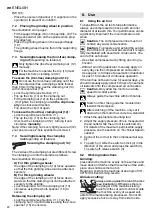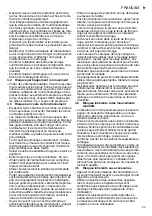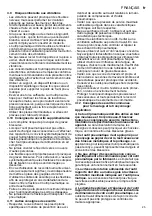
ENGLISH
en
18
away from the operator, depending on the direction
of the wheel’s movement at the point of jamming.
Grinding wheels may also break under these condi-
tions.
Kickback is the result of air tool misuse and/or incor-
rect operating procedures or conditions. It can be
avoided by taking proper precautions as given
below.
a)
Maintain a firm grip on the air tool and posi-
tion your body and arm to allow you to resist
kickback forces. Always use the auxiliary
handle, if provided, maximum control over
kickback or torque reaction during start-up.
The operator can control torque reactions or kick-
back forces, if proper precautions are taken.
b)
Never place your hand near the rotating
mounted tool.
In the event of kickback, the
mounted tool may be propelled over your hand.
c)
Do not allow your body to enter the area where
the air tool would move if kickback occurs.
Kickback will propel
the air tool in the opposite direction of the wheel’s
movement at the point of jamming.
d)
Use special care when working around
corners, sharp edges etc. You must prevent
mounting tools from bouncing off the work-
piece and becoming jammed.
A rotating mounted
tool tends to jam around corners and sharp edges
and also if bouncing occurs, thus causing loss of
control or kickback.
e)
Do not attach a saw chain woodcarving
blade or toothed saw blade.
This type of mounted
tool frequently results in kickback and loss of control
over the air tool.
4.14 Specific safety instructions for grinding
and abrasive cutting:
a)
Use only wheel types that are recommended
for your air tool and the specific guard
designed for the selected wheel.
Wheels for
which the air tool was not designed cannot be
adequately guarded and are unsafe.
b)
The guard must be securely attached to the
air tool and positioned for maximum safety, so
that the least amount of wheel is exposed
towards the operator.
The guard helps to protect
the operator from broken fragments, accidental
contact with the wheel and sparks that could ignite
clothing.
c)
Wheels must be used only for recommended
applications.
For example: do not grind with the side of the
cut-off wheel.
Abrasive cut-off wheels are
intended for peripheral grinding. Lateral forces
applied to these wheels may cause them to shatter.
d)
Always use undamaged wheel flanges that
are of correct size and shape for your selected
wheel.
Proper wheel flanges support the wheel
thus reducing the possibility of wheel breakage.
Flanges for cut-off wheels may be different from
grinding wheel flanges.
e)
Do not use worn down grinding wheels from
larger air tools.
Wheels intended for larger air tools
are not suitable for the higher rotational speeds of
smaller air tools and may break.
4.15 Additional safety warnings for abrasive
cutting:
a)
Do not “jam” the cut-off wheel or apply
excessive pressure. Do not attempt to make
excessively deep cuts.
Overstressing the cut-off
wheel increases the loading and susceptibility to
twisting or binding of the wheel in the cut and the
possibility of kickback or wheel breakage.
b)
Do not position your body in line with and
behind the rotating cut-off wheel.
When you
move the cut-off wheel in the workpiece away from
your body, possible kickback may propel the air tool
and the spinning wheel directly at you.
c)
If the wheel jams or if you interrupt a cut for
any reason, switch off the device and hold it
motionless until the wheel comes to a complete
stop. Never attempt to remove the cut-off wheel
from the cut while the wheel is in motion, other-
wise kickback may occur.
Investigate and take
corrective action to eliminate the cause of the wheel
jam.
d)
Do not switch the air tool back on while it is
in the workpiece. Let the wheel reach full speed
and carefully reenter the cut.
The wheel may jam,
walk up or kickback if the air tool is restarted in the
workpiece.
e)
Support panels or any oversized workpiece
to minimise the risk of wheel pinching and kick-
back.
Large workpieces tend to sag under their own
weight. Supports must be placed under the work-
piece near the line of cut and near the edge of the
workpiece on both sides of the wheel.
f)
Use extra caution when making a "pocket
cut" into existing walls or other blind areas.
The
protruding wheel may cut gas or water pipes, elec-
trical wiring or objects that can cause kickback.
4.16 Additional safety instructions
WARNING
– Always wear protective
goggles.
Use elastic cushioning layers if they have been
supplied with the abrasive and if required.
Observe the specifications of the tool or accessory
manufacturer! Protect the discs from grease or
impacts!
Grinding wheels must be stored and handled with
care in accordance with the manufacturer's instruc-
tions.
Never use parting grinder discs for roughing work.
Do not apply pressure to the side of parting grinder
discs.
The workpiece must be seated firmly and be
secured against slipping, e.g. using clamps. Large
workpieces must be supported adequately.
If mounted tools with threaded inserts are used, the
end of the spindle may not touch the base of the
hole on the grinding tool. Make sure that the thread
















































